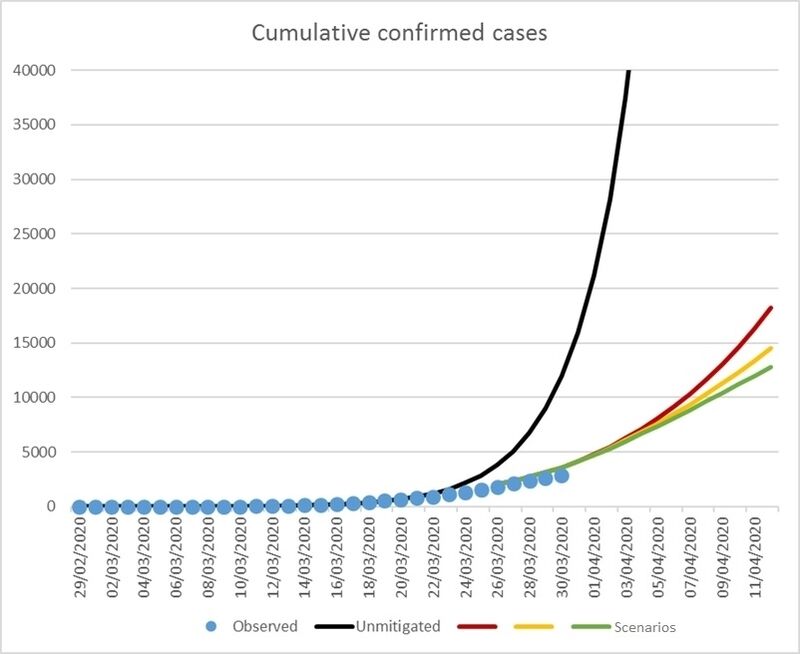Maresa Fagan: The curve must be flattened if our hospitals are to manage the Covid-19 surge

While the growth rate of the coronavirus in Ireland might be slowing, we have to stay at home en masse, otherwise we’ll have 20,000 cases by mid-April, writes
The growth curve for Covid-19 in Ireland must be flattened in the days ahead, if the healthcare system is to cope with an expected surge in cases, which, in the best-case scenario, will exceed 12,000.
We are still in the grip of the coronavirus.
Every day, more cases of this new, highly infectious, and potentially lethal virus are confirmed in Ireland and across the world. The global death toll is 40,000 and the toll in Ireland is 50. That is stark.
The number of Covid-19 cases now exceeds 750,000 around the world; the number in Ireland is approaching 3,000 and likely to rise significantly in the coming days and weeks.
The good news is that the Covid-19 growth rate in Ireland is showing signs of slowing.
The not-so-good news is that we need to hold our nerve and continue to comply with current restrictions on movement and social-distancing to keep the numbers down.
This is not the time to let Covid-19 tighten its grip, as it has done in Italy and elsewhere.
On Monday, government-appointed experts gave an update on the current Covid-19 picture in Ireland. It was both sobering and cautious, with a clear message for people to stay at home.
The pace of growth, or cumulative rise in the number of new cases confirmed, is showing signs of slowing down.
The actions taken by the Government, to date, are stemming the tide of Covid-19, but there is still a way to go.
In one month, Ireland has seen the number of cases grow from one, on February 29, to close to 3,000, this week.
That figure, however, could have been closer to 40,000 confirmed cases, if no actions were taken to mitigate the emerging public health threat.
That’s according to modelling projections given by the National Public Health Emergency Team (NPHET) this week.
In the best-case scenario, Ireland could have 12,000 cases of Covid-19 by Saturday week, April 11.

A more pessimistic forecast estimates between 15,000 and 20,000.
The gradual restrictions on the movement of people, experts say, are slowing the spread of infection.
The growth rate of Covid-19 has been halved in recent days, but greater efforts are needed and the next fortnight will be critical.
Philip Nolan, who chairs the expert epidemiological modelling advisory group, said the country was not on the “unmitigated epidemic” track, but cautioned that the next fortnight is vital in keeping the numbers down.
“The model reveals that before restrictions were in place, daily growth rate of confirmed cases was at 33%. This has fallen in recent days, to around 15%.
“But it is still growing and needs to fall further,” Prof Nolan said.
The actual or observed number of Covid-19 cases in Ireland, as shown in the chart provided by the expert group to the Department of Health, is currently following the best-case scenario.
This can only happen, though, if everyone complies with current restrictions to stay at home, and to self-isolate if showing symptoms.
The impact of the more drastic lockdown measures announced last Friday will be seen within the next two weeks, as Prof Nolan explained: “It takes time to see the impact of our efforts in the numbers. It will be another 7-10 days before we have a reliable picture of how effective our collective efforts have been.”
The expert group conceded that it is not possible to forecast when the virus will peak, but they expect that we will be living with Covid-19 into the near future.
The objective is to flatten the curve by slowing down the spread of infection, as China and South Korea did.
Both countries did so by restricting the movement of their citizens, carrying out widespread testing, by contact tracing, and also by quarantining those who showed mild symptoms.
Such measures helped to lower and push out the peak to a later date, so that the number of cases was more manageable.
At the other end of the scale, there are lessons to be learnt from Italy, where 11,500 people, including healthcare staff, have died to date.
There, the number of Covid-19 cases grew such that hospitals became the source of infection and the healthcare system became overwhelmed.
There is much that the medical and scientific world do not know about this virus and how it works and spreads, and that is an added complication.
There is evidence that between 20% and 60% of Covid-19 infections could go undetected, because the symptoms are so mild, and that is a large unknown quantity to manage.
That is why Covid-19 has the power to overwhelm health services and that is the concern in Ireland and elsewhere.
What we do know is that the virus is infecting all age groups in Ireland and that one in four of those infected are hospitalised.
Figures also show that one in four confirmed Covid-19 cases are healthcare workers.
Flattening the Covid-19 growth curve is not a choice in Ireland. It is critical, if the healthcare system is to cope with the estimated 12,000-plus cases of Covid-19 by mid-April.
The healthcare service is currently responding well to the Covid-19 outbreak, but it also has its limits.
Already, close to 90 people infected by Covid-19 have been placed in intensive care and the number of ICU admissions has doubled in the past week. There are fewer than 200 ICU beds across the country.
In the meantime, the healthcare system is bracing itself for a Covid-19 surge.
A different type of intensive care model is being developed to cope with people who are seriously ill. Every hospital has a surge plan. There are contingencies for more beds and staffing.
While additional provisions are being made for the worst-case scenario, the Government is stressing that the best-case scenario can only be attained if citizens play their part and stay at home.
As the chief medical officer at the Department of Health said this week, there is no room for complacency in the days ahead.
“We are beginning to see encouraging signs in our efforts to flatten the curve. However, we cannot become complacent, as we are still seeing new cases and more ICU admissions every day,” Dr Tony Holohan said.
“Our strategy remains the implementation of public health restrictions to interrupt the spread of the virus and prevent people from arriving to ICU in first place,” he added.
- Shop for essential food and household goods;
- Attend medical appointments, collect medicine or other health products;
- Care for children, older people or other vulnerable people - this excludes social family visits;
- Exercise outdoors - within 2kms of your home and only with members of your own household, keeping 2 metres distance between you and other people
- Travel to work if you provide an essential service - be sure to practice social distancing
















